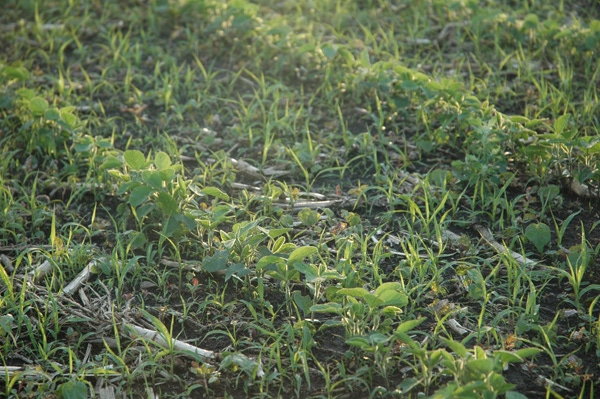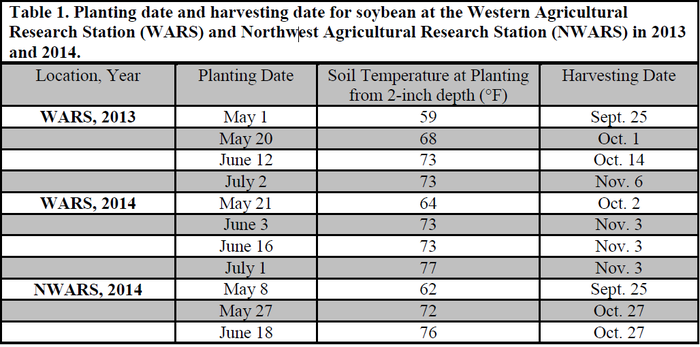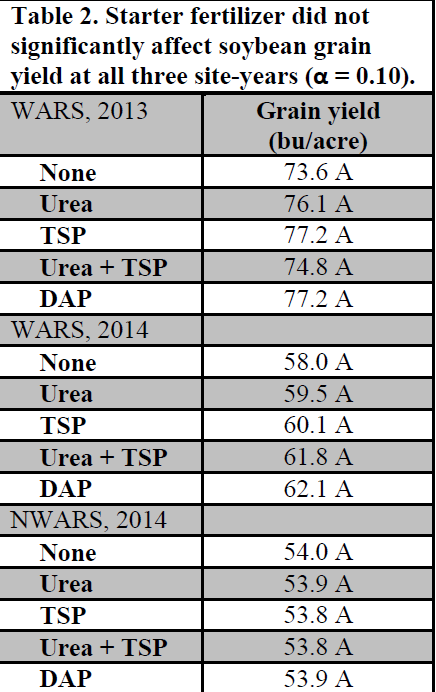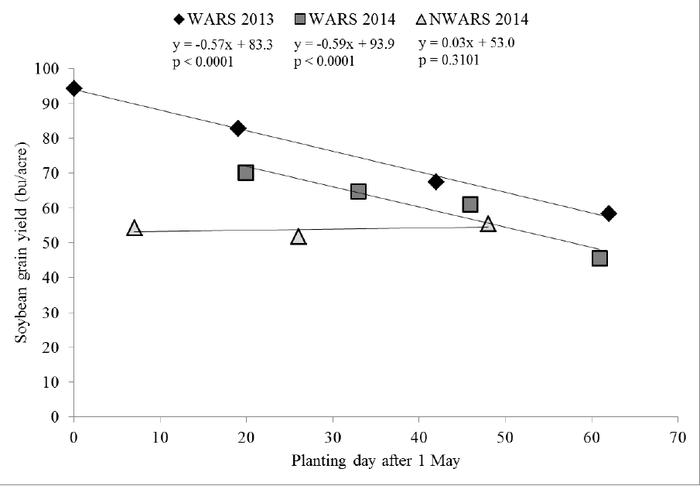April 20, 2017

By Matthew W. Hankinson, Laura E. Lindsey, and Steven W. Culman
A trial was established at the Western Agricultural Research Station (WARS) in South Charleston, Ohio and at the Northwest Agricultural Research Station (NWARS) in Custar, Ohio to evaluate the effect of starter fertilizer on soybean grain yield across several soybean planting dates.
QUICK TAKE-AWAY:
Nitrogen (N) and phosphorus (P) starter fertilizer did not increase soybean grain yield. However, all three site-years had soil P levels greater than the critical level of 15 ppm (Bray P).
Soybeans planted on May 1 at the South Charleston, Ohio location yielded 94 bu/acre. Even at high yields, there was no yield response to starter N or P fertilizer.
Soybean yield decreased by 0.6 bu/acre/day when soybeans were planted after the first planting date at the South Charleston location in both years.
Timely planting is much more critical for maximizing soybean yield than use of starter fertilizer.
Methods
The trial was established in 2013 and 2014 at WARS and 2014 at NWARS. The soil series was Kokomo silty clay loam at WARS and Hoytville clay at NWARS. At all research locations, the previous crop was corn. The WARS location was minimally tilled in the fall, and the NWARS location was minimally tilled in the fall and spring. Soybeans were planted in 30-inch rows to facilitate starter fertilizer application. Soybeans, Asgrow 3231 (3.2 relative maturity), treated with Acceleron were planted at 145,000 seeds/acre.
Three to four planting dates were evaluated at each location ranging from May 1 through July 2 (Table 1). Starter fertilizer treatments were applied in a band 2 inches beside and 2 inches below the seed at planting. Starter fertilizer evaluated included:
None (control)
Urea at 30 lb N/acre
Triple super phosphate (TSP) at 40 lb P2O5/acre
Urea + TSP at 30 lb N/acre and 40 lb P2O5/acre
Diammonium phosphate (DAP) at 40 lb P2O5/acre and 16 lb N/acre
Prior to planting, a soil sample was collected at 0 to 8 inch depth for nutrient analysis. Soil P (Bray P) was 33 ppm, 38 ppm, and 84 ppm at the WARS 2013, WARS 2014, and NWARS 2014 locations, respectively. Soil P was not limiting at any of the trial locations.

Effect of starter fertilizer on soybean grain yield
Starter fertilizer had no effect on soybean grain yield at any of the locations (Table 2). The soil P level at all three site-years was >15 ppm which is the established P critical level for Ohio (Vitosh et al., 1995). If the soil P levels were <15 ppm, a yield response to P starter fertilizer would have been much more likely to occur. In previously conducted studies, soybean yield response to N application in soybean was variable and generally occurred under high-yielding conditions when biological N fixation and soil residual N did no supply sufficient N to meet crop demand (Salvagiotti et al., 2008). Soil organic matter was 3.6 to 4.0% for the three site-years, which may have resulted in sufficient N mineralization to meet crop demand causing the lack of yield response to starter N fertilizer (Sawyer et al., 2006). At the WARS location in 2013, soybean yield was 94 bu/acre when planted on May 1; however, starter N fertilizer did not increase soybean yield, indicating that biological N fixation and soil residual N were adequate.

Effect of planting date on soybean grain yeld
Soybean grain yield was influenced by planting date at the WARS location, but not the NWARS location. Soybean grain yield decreased by 0.6 bu/acre/day at the WARS location both years when soybeans were planted after the first planting date (Figure 1). Soybean grain yield was not affected by planting date at the NWARS location.

Figure 1. Effect of soybean planting date on soybean grain yield at the Western Agricultural Research Station (WARS) in 2013 and 2014 and the Northwest Agricultural Research Station (NWARS) in 2014.
You May Also Like




